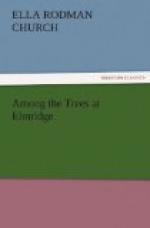“It seems,” continued Miss Harson, “that the apple tree grows wild in every part of Europe except in the frigid zone and in Western Asia, China and Japan. It is thought to have been planted in Britain by the Romans; and when it was brought here, it seemed to do better than it had done anywhere else. It is said that ’not only the Indians, but many indigenous insects, birds and quadrupeds, welcomed the apple tree to these shores. The butterfly of the tent-caterpillar saddled her eggs on the very first twig that was formed, and it has since shared her affections with the wild cherry; and the canker-worm also, in a measure, abandoned the elm to feed on it. As it grew apace the bluebird, robin, cherry-bird, king-bird, and many more, came with haste and built their nests and warbled in its boughs, and so became orchard-birds and multiplied more than ever. It was an era in the history of their race in America. The downy woodpecker found such a savory morsel under its bark that he perforated it in a ring quite round the tree before he left it. It did not take the partridge long to find out how sweet its buds were, and every winter eve she flew, and still flies, from the wood to pluck them, much to the farmer’s sorrow. The rabbit, too, was not slow to learn the taste of its twigs and bark; and when the fruit was ripe, the squirrel half rolled, half carried, it to his hole. Even the musquash crept up the bank from the brook at evening, and greedily devoured it, until he had worn a path in the grass there; and when it was frozen and thawed, the crow and the jay were glad to taste it occasionally. The owl crept into the first apple tree that became hollow, and fairly hooted with delight, finding it just the place for him; so, settling down into it, he has remained there ever since.’
“Speaking of these buds, Clara,” said her governess, “I think I forgot to tell you that the apple tree belongs to the family Rosaceae, and therefore the half-opened blossoms have a right to look like roses. The tree is not a handsome one, being a small edition of the oak in its sturdy outline, but it is less graceful or picturesque-looking, being often broader than it is high and resembling in shape a half globe. The leaves are not pretty except when first unfolded, and their color is then a beautiful light tint known as apple-green. But the foliage soon becomes dusty and shabby-looking. An old apple tree, with its gnarled, and often hollow, trunk, is generally handsomer than a young one, unless in the time of blossoms; for only a young apple-orchard is covered with such a profusion of bloom as that we saw to-day.”
“I am glad,” said Clara, “that it belongs to the rose family, for now the dear little buds seem prettier than ever.”
“The apples are prettier yet,” observed
Malcolm; “if there’s anything I like, it’s apples.”
“I am afraid that you eat too many of them for your good,” replied his governess; “I shall have to limit you to so many a day.”




